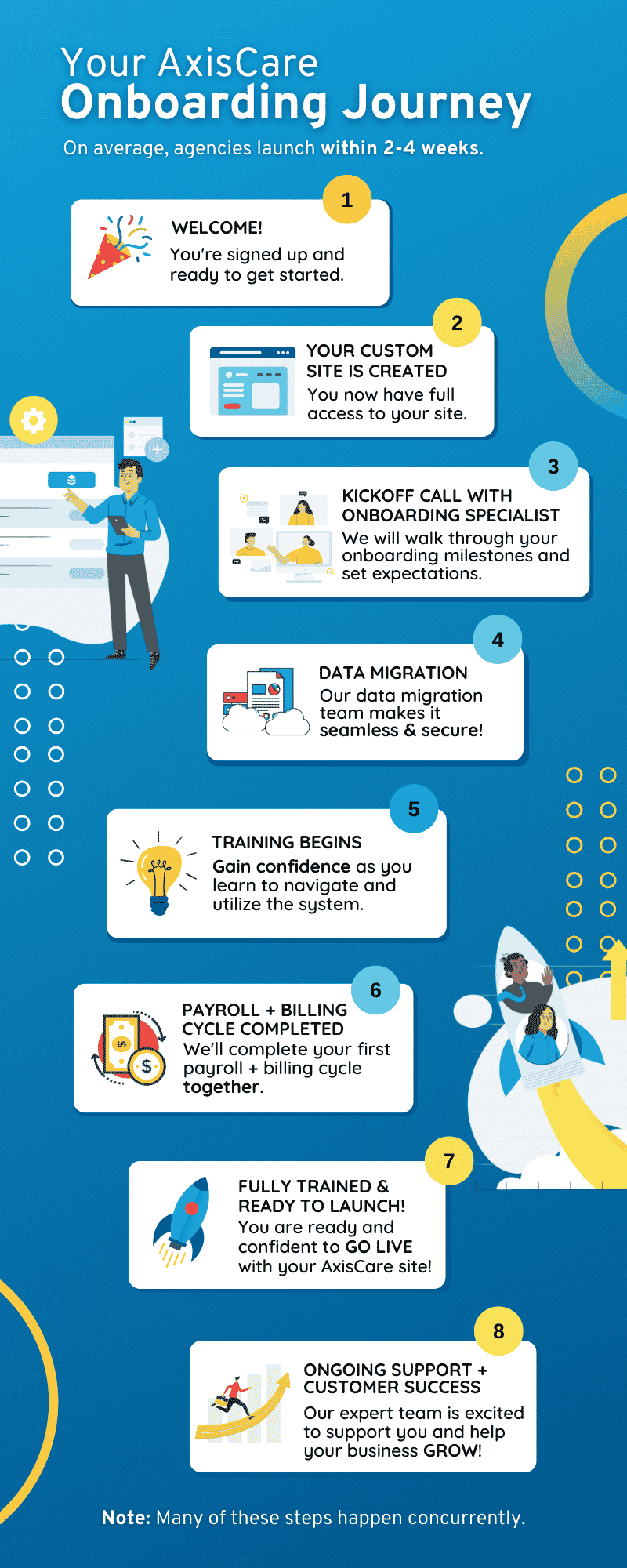According to a third-party survey commissioned by AxisCare, 94% of agencies recognized expansion into new territories as an opportunity for growth. But you can’t simply translate your operations in one region directly onto another; demographic quirks, local regulations, and scaling considerations will all come into play.
As demand continues to rise astronomically, expansion is one of the most prominent home care trends in 2024. We’re here to help you through the planning and ideation process – here’s where to start.
1. Understand the New Territory
Patient needs are broadly the same from coast to coast. But on a more technical level, agencies will need a profound understanding of local regulatory frameworks and demographic data.
Research the Market
Begin with a situational analysis of your new area. Research the population’s age distribution and health needs and ensure it has a satisfactory proportion of elderly residents or individuals with chronic illnesses. You will also want to analyze the landscape of existing home health providers: is the market already saturated? Does your agency provide services that don’t yet exist in this region? How does your pricing compare?
Economic stability and growth trends should also play a role; expanding into a territory that does not have the means to afford your services is not a compelling business proposition. On the other hand, if your agency serves many Medicaid patients and is well-connected in this space, that may change the demographic makeup of your desired location.
Legal & Regulatory Considerations
Every US state has its own set of requirements for setting up a home care agency. These local laws exist to ensure regulatory compliance and patient safety; understanding them is key to avoiding legal pitfalls when expanding your agency’s footprint.
For example, different states have their own rules for how to obtain a home care license or permit, how to train and provide accreditation for staff, and which operational policies (like opening hours) must be followed. Medicaid billing laws also vary by state, so it’s important to understand how reimbursement will work in your chosen territory.
2. Develop a Strategic Plan
Once you’ve chosen where you’d like to expand, it will be time to get strategic. Here’s how to craft a plan tailored to your new territory’s specific needs.
Set Clear Objectives
Outline the growth targets and milestones that will guide your expansion efforts and measure your success. Every agency must define which factors are most important when deciding whether an initiative has been successful, whether it’s billed hours, a client census, revenue growth, or otherwise.
Identify Target Clients
Defining a strategy for attracting and retaining clients is a crucial part of this calculus. Home care agencies are, of course, meant to serve older adults. However, the demographic makeup of your new region may come with certain specific needs, and your service offering may be well-positioned to plug gaps in the market.
Build Partnerships & Networks
Before you break ground at your new location, start sowing the seeds of your new network. That way, you’ll be arriving with connections ready to go. Building a network of referrals and potential clients is a good way to prepare for moving into a new territory and will provide a clearer picture of the market opportunity available to you.
3. Operational Considerations
What will day-to-day life look like at your new location, or locations plural? Setting yourself up for success includes considering routine functions like staffing and technological integration.
Staffing & Training
Depending on the size of the local market and your facilities, you may need more or less staff on hand than you’re used to. Ensuring that you have enough bandwidth, employees, and adequate training is essential for moving into a new territory, especially given how difficult it can be to attract and retain caregivers in this industry.
Technology & Infrastructure
It’s impossible to run a multi-location business without the help of technology – and, in this case, home care software. These specialized platforms offer a full suite of digital tools that remove operational friction while reducing wasted time and resources.
Electronic visit verification (EVV), for example, can support an agency’s expansion by ensuring compliance with state and federal regulations, reducing administrative burdens through automated scheduling and billing, and enhancing care quality with real-time visit verification.
What’s more, remote patient monitoring (RPM) tools deliver health information straight to practitioners’ devices, enabling enhanced collaboration between disparate healthcare professionals.
Client Spotlight: Amada Senior Care
Amada Senior Care needed 90+ locations’ worth of data fully transferred over and their entire staff trained within a 45-day period. After vetting three popular software platforms, they ultimately chose AxisCare for the following benefits:
- Ability to customize and personalize their solution
- Attentiveness and willingness to develop features according to their unique needs
- Robust franchise and franchisee reporting tools
- Preparedness to handle onboarding 90+ franchise locations in a short time
- Industry-leading client support team
Click here to learn more about this AxisCare success story.
4. Measure Success & Adjust Strategies
Analysis tools and reporting software for home care are equivalent to an X-ray for your agency. They can help you understand if your systems are working properly and which parts of the business need more urgent attention.
Track Key Performance Indicators (KPIs)
No expansion is complete without a system for tracking KPIs. Understanding your successes and weaker areas will tell you everything you need to know about how to improve in the present, while paving the way for further expansions in the future.
Business Intelligence (BI) tools are tailor-made for this purpose. They collect and analyze information and then provide actionable insights to help agencies make data-driven decisions. KPI markers include gross revenue, active clients, caregiver turnover, and referral source statistics.
Continuous Improvement
Business intelligence for home care can also help you implement a continuous improvement process to adapt and refine your strategies based on performance data and feedback. Using this information to produce reports is a great way to evaluate your organization’s overall health and maintain a crystal-clear view of which areas need help.
That being said, the quality of your reporting will only be as good as the orderliness of your data. Regularly auditing your data lake for inconsistencies, duplicates, and outdated information is a must; new clients, staff, and information are constantly rolling in, creating a constant need for strong “data hygiene” practices.
Navigate a New Home Care Territory Successfully
Every successful expansion starts with technology. The right tools will keep your entire team connected across territories while keeping a constant finger on the pulse of your agency’s performance.
Want to learn more? Book a free demo.









